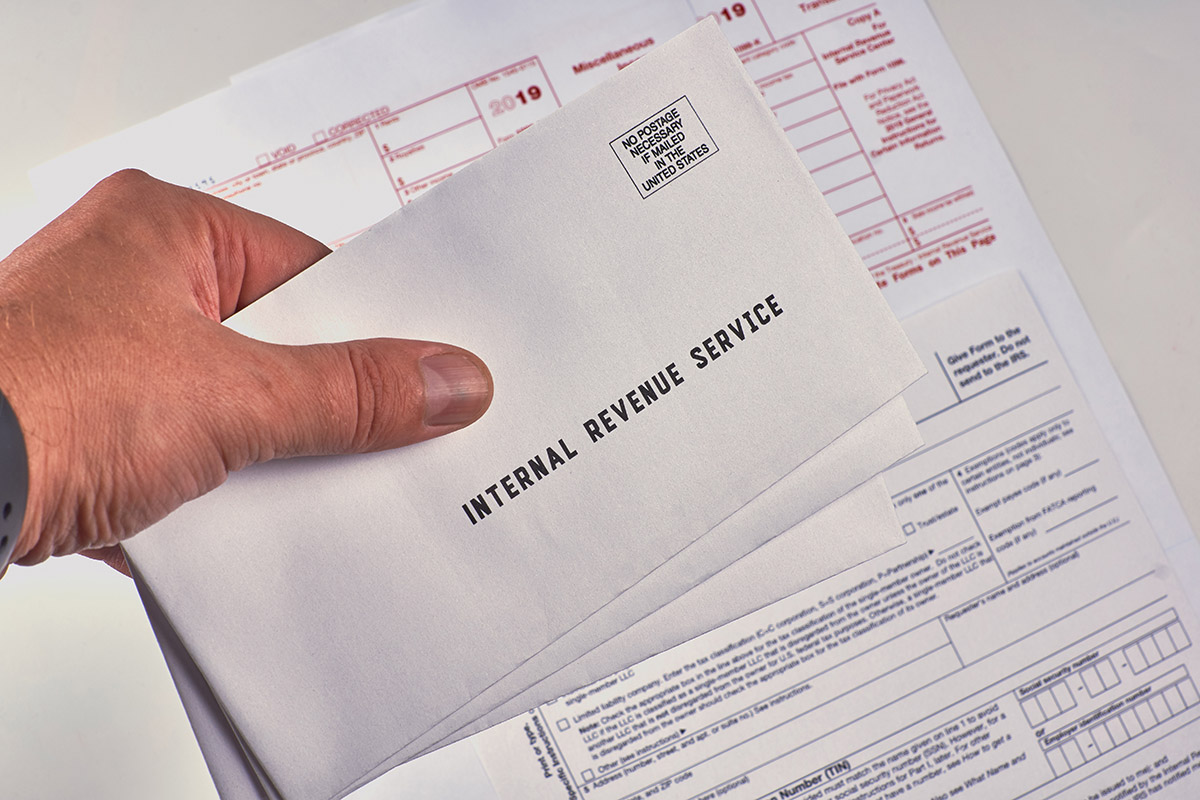

Finance
Where To Mail A Tax Return
Published: October 29, 2023
Looking for the right place to mail your tax return? Explore our comprehensive guide and find out where to send your tax documents and returns. Finance made simple.
(Many of the links in this article redirect to a specific reviewed product. Your purchase of these products through affiliate links helps to generate commission for LiveWell, at no extra cost. Learn more)
Table of Contents
Introduction
Welcome to the world of taxes! Filing your tax return is an important annual task that can sometimes feel overwhelming. Whether you’re a seasoned taxpayer or a first-timer, knowing where to mail your tax return is a crucial step in the process. In this guide, we will explore the various options and considerations for mailing your tax return.
Filing your tax return accurately and on time is not only a legal obligation but also a way to ensure that you are paying the correct amount of taxes. It’s important to understand that the location to which you mail your tax return will depend on whether you are filing a federal tax return or a state tax return.
Throughout this article, we will provide you with the necessary information to determine where to mail your tax return, whether you are filing your federal tax return or a state tax return. We will also delve into the different mailing options available and important considerations to keep in mind.
It’s worth noting that the information provided here is based on general guidelines. It’s always a good idea to check with the appropriate tax authority or consult a tax professional for the most accurate and up-to-date information regarding your specific tax situation.
Now, let’s dive into the nitty-gritty details of the tax return mailing process and explore where you need to send your tax return!
Understanding the Tax Return Process
Before we delve into where to mail your tax return, let’s take a moment to understand the tax return process and its importance. A tax return is a document that individuals and businesses file with the respective tax authorities to report their income, deductions, and tax liability for a specific period, typically a calendar year.
When filing your tax return, you must accurately report all sources of income, such as salaries, investments, and self-employment earnings. You can also claim deductions and credits to reduce your overall tax liability and potentially receive a tax refund.
The tax return process can vary depending on whether you are filing a federal tax return or a state tax return. In the United States, the Internal Revenue Service (IRS) is responsible for administering federal taxes, while each state has its own tax authority to manage state taxes.
Here are the key steps involved in the tax return process:
- Gather necessary documents: Before you begin filling out your tax return, gather all relevant documents, including W-2 forms, 1099 forms, and receipts for deductions. Having these documents on hand will help ensure accuracy when reporting your income and claiming deductions or credits.
- Choose your filing status: Your filing status determines the tax brackets and deductions you are eligible for. Common filing statuses include single, married filing jointly, married filing separately, and head of household.
- Calculate your income: Total up all sources of income, including wages, interest, dividends, self-employment earnings, and any other taxable income. Each type of income may have specific reporting requirements.
- Claim deductions and credits: Deductions and credits can help reduce your taxable income and potentially lower your overall tax liability. Common deductions include mortgage interest, student loan interest, and medical expenses. Popular credits include the Child Tax Credit and the Earned Income Tax Credit.
- Fill out the appropriate forms: Depending on your individual circumstances, you will need to fill out specific tax forms. For federal taxes, the most common form is the Form 1040. States typically have their own tax forms that you need to complete.
- Double-check and review: Before submitting your tax return, carefully review all the information you have entered. Check for errors or omissions that could trigger an audit or delay the processing of your return.
- Sign and date: Once you are confident that your tax return is accurate, sign and date the appropriate forms. Electronic filing usually requires a digital signature, while paper filings require a physical signature.
Understanding the tax return process is essential for accurately completing and filing your tax return. With a clear understanding of the steps involved, you can now proceed to determine where to mail your tax return, whether it’s a federal or state return.
Where to Mail Your Tax Return
Knowing where to mail your tax return is crucial to ensure it reaches the right tax authorities in a timely manner. The mailing address for your tax return will depend on whether you are filing a federal tax return or a state tax return.
Mailing options for federal tax returns
When it comes to mailing your federal tax return, the address you use will depend on several factors, including your state of residence, whether you are enclosing a payment, and whether you are using a private delivery service.
The IRS provides different mailing addresses for taxpayers who are enclosing a payment and taxpayers who are not enclosing a payment. It’s important to carefully review the instructions on the IRS website or the specific tax form you are using to determine the correct mailing address.
If you are using a private delivery service, such as FedEx or UPS, you will need to use the designated IRS street address rather than the P.O. Box address. This is to ensure that your tax return is delivered to the IRS in a timely fashion.
Mailing options for state tax returns
State tax returns generally have their own specific mailing addresses. Each state has its own tax authority, and they provide instructions on where to mail your state tax return.
Most states have dedicated mailing addresses for tax returns with payments and for tax returns without payments. It’s essential to consult the instructions provided by your state’s tax authority or visit their website to find the correct address for mailing your state tax return.
Some states may also have multiple addresses depending on the type of tax return or the specific form being filed. Make sure to double-check and ensure that you are using the correct address for your specific situation.
Considerations for mailing your tax return
When mailing your tax return, keep in mind the following considerations:
- Timely filing: Ensure that you mail your tax return on or before the filing deadline. Late-filed tax returns may incur penalties and interest.
- Accurate addressing: Double-check the mailing address and make sure it is accurate. Using incorrect or outdated addresses can result in your tax return being undeliverable.
- Proof of mailing: Consider sending your tax return via certified mail with return receipt requested. This provides proof that you mailed your return on time and allows you to track its delivery.
- Filing electronically: In many cases, filing your tax return electronically is faster, more secure, and can help expedite the processing of your return. Consider e-filing as an alternative to traditional paper filing.
Lastly, always remember to keep a copy of your tax return and any supporting documentation for your records. This is important for future reference or in case of any inquiries or audits by tax authorities.
By following the correct mailing instructions and considering these important factors, you can ensure that your tax return is successfully delivered to the appropriate tax authorities and avoid any potential issues or delays in the processing of your return.
Mailing Options for Federal Tax Returns
When it comes to mailing your federal tax return, there are specific options and considerations to keep in mind. The mailing address you use will depend on factors such as whether you are enclosing a payment, your state of residence, and whether you are using a private delivery service.
If you are filing your federal tax return using the United States Postal Service (USPS), you will need to ensure that your tax return is postmarked by the filing deadline. The IRS provides different mailing addresses based on whether you are enclosing a payment or not. It is crucial to carefully follow the instructions provided by the IRS to ensure that your tax return reaches the correct destination.
If you are enclosing a payment with your tax return, make sure to use the appropriate IRS payment mailing address. The IRS advises using a separate envelope for your payment and ensuring that it is securely attached to your tax return.
If you choose to use a private delivery service, such as FedEx or UPS, the IRS has designated specific street addresses for different locations across the United States. It is important to use the appropriate street address rather than the P.O. Box address when using a private delivery service. This ensures that your tax return is delivered promptly to the IRS, minimizing any potential delays.
When using a private delivery service, it is essential to refer to the IRS guidelines and verify the approved list of delivery services to ensure that the service you choose is recognized by the IRS for tax return mailing purposes.
It is worth noting that the IRS strongly encourages taxpayers to file their tax returns electronically rather than mailing a paper return. Electronic filing offers several advantages, including faster processing, increased accuracy, and a reduced risk of errors. Additionally, electronic filing can help expedite any potential refund you may be entitled to.
Before using any mailing option, it is essential to review the instructions provided by the IRS and consult the most up-to-date information on their website. The IRS regularly updates their mailing addresses and guidelines, so it is crucial to stay informed to ensure your tax return reaches the correct destination in a timely manner.
In summary, when mailing your federal tax return, make sure to carefully follow the instructions provided by the IRS based on your specific circumstances. Whether you choose to use the USPS or a private delivery service, ensure that you use the correct mailing address, meet the required postmark deadlines, and consider electronic filing as an efficient and secure alternative.
Mailing Options for State Tax Returns
When it comes to filing your state tax return, it’s essential to understand the specific mailing options and instructions provided by your state’s tax authority. Each state has its own tax agency responsible for administering state taxes, and they will have specific guidelines for where to mail your state tax return.
Most states offer multiple mailing addresses depending on whether you are including a payment with your tax return or not. When filing your state tax return, carefully review the instructions provided by your state’s tax authority to determine the correct mailing address for your specific situation.
Some states provide separate addresses for paper return filings without payments and for paper return filings with payments. If you are enclosing a payment, it is crucial to use the correct payment mailing address to ensure that your payment is processed accurately.
State tax authorities often provide detailed guidelines on their websites or in their tax return instruction booklets. These resources will include the necessary mailing addresses and instructions specific to your state. Be sure to consult these resources to ensure that your state tax return reaches the appropriate agency.
In addition to traditional mail, many states also offer electronic filing options for state tax returns. Electronic filing allows you to submit your tax return online, often providing faster processing and a reduced risk of errors. Moreover, electronic filing may also enable you to receive your tax refund more quickly if applicable.
Before choosing a mailing option for your state tax return, consider the following points:
- Review instructions: Carefully read the instructions provided by your state’s tax authority to determine the correct mailing address and any specific requirements.
- Check for separate addresses: Be aware of separate addresses for return-only filings and for filings with payments, if applicable.
- Consider electronic filing: Explore the option of electronically filing your state tax return if available. It can provide a more efficient and secure method of submission.
- Mailing deadlines: Make sure to mail your state tax return on or before the due date specified by your state’s tax authority.
- Proof of mailing: Consider sending your state tax return via certified mail or with return receipt requested to have proof of mailing and track its delivery.
By following the specific mailing instructions provided by your state’s tax authority and considering these factors, you can ensure that your state tax return is properly mailed and reaches the appropriate agency on time.
Remember, each state may have different guidelines and requirements, so it’s essential to consult the instructions specific to your state’s tax authority or visit their website for the most up-to-date information.
Considerations for Mailing Your Tax Return
When it comes to mailing your tax return, there are several important considerations to keep in mind. These considerations can help ensure that your tax return is successfully delivered to the appropriate tax authorities and processed accurately and efficiently.
- Timely Filing: It is crucial to mail your tax return on or before the filing deadline. Late-filed tax returns may incur penalties and interest. Be aware of the specific deadline for your federal and state tax returns, as they may have different due dates.
- Accurate Addressing: Double-check the mailing address provided by the IRS or your state’s tax authority to ensure accuracy. Using an incorrect or outdated address can result in your tax return being undeliverable and potentially causing delays in processing.
- Separate Payments: If you are enclosing a payment with your tax return, make sure to follow the instructions and guidelines provided by the IRS or your state’s tax authority. Consider using a separate envelope for the payment and attaching it securely to your tax return.
- Proof of Mailing: To have proof that you filed your tax return on time and to track its delivery, consider sending it via certified mail with return receipt requested. This provides documentation and verification of the mailing date and delivery confirmation.
- Electronic Filing: Electronic filing offers numerous advantages, including faster processing, increased accuracy, and the potential for quicker tax refunds. Consider filing your tax return electronically instead of mailing a paper return, if possible.
- Record Keeping: Keep copies of your filed tax return, any supporting documentation, and proof of mailing for your records. This is important for reference purposes, especially in case of any inquiries or audits by tax authorities.
It’s important to note that the information provided here is based on general guidelines. Always refer to the IRS website or the specific tax authority in your state for the most up-to-date and accurate information regarding any specific mailing instructions or requirements.
By following these considerations, you can help ensure that your tax return is properly mailed and reaches the appropriate tax authorities on time. Filing your tax return accurately and punctually is not only a legal obligation but also ensures that you pay the correct amount of taxes and avoid any penalties or delays in processing.
Remember, if you have any doubts or questions regarding the mailing process or need assistance with your tax return, it is advisable to consult a tax professional or reach out to the appropriate tax authority for guidance.
Conclusion
Filing your tax return is an important responsibility that requires careful attention to detail, including knowing where to mail your tax return. Whether you are filing a federal tax return or a state tax return, understanding the appropriate mailing options and considerations is crucial to ensure that your tax return reaches the correct tax authorities in a timely manner.
Throughout this guide, we have explored the key aspects of the tax return mailing process. We discussed the importance of understanding the tax return process itself, including gathering necessary documents, choosing your filing status, and calculating your income and deductions accurately.
We then delved into where to mail your tax return, considering the mailing options for both federal tax returns and state tax returns. We highlighted the need to consult the appropriate addresses provided by the IRS and your state’s tax authority, especially when it comes to enclosing payments or using private delivery services.
Additionally, we discussed essential considerations for mailing your tax return, including the importance of timely filing, accurate addressing, proof of mailing, and considering electronic filing as a more efficient and secure option.
To ensure compliance with the ever-changing tax regulations, always refer to the specific instructions provided by the IRS and your state’s tax authority for up-to-date and accurate information regarding your tax return mailing obligations.
Remember, the tax return filing process can be complex, and seeking guidance from a tax professional or consulting the appropriate tax authority is always advisable, especially if you have specific questions or concerns.
By following the guidelines and considerations outlined in this article, you can navigate the tax return mailing process with confidence, ensuring that your tax return is properly submitted and minimizing the chances of any penalties or delays.
Now that you have the knowledge and understanding of where to mail your tax return and the associated considerations, you can approach the tax filing season with ease and ensure a smooth and successful filing process.














